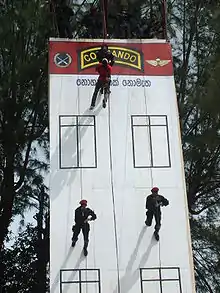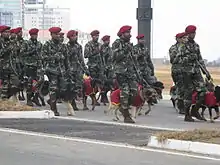Sri Lanka Army Commando Regiment
The Sri Lanka Army Commando Regiment (Sinhala: කොමාන්ඩෝ රෙජිමේන්තුව komāndo rejimēnthuwa; Tamil: இலங்கை இராணுவத்தின் கமாண்டோ படைப்பிரிவ) is one of two Special Operations units of the Sri Lanka Army, alongside the Sri Lanka Army Special Forces Regiment. The organizational and operational Structure of the Sri Lanka Army Commando Regiment is much similar to the British Special Air Service (SAS) unit. Within one of the four Army Commando Regiments there is a 140-man counter-terrorist unit that provides the primary counter-terrorism response for Sri Lanka. This unit was created in 1980 and is based in Ganemulla, a suburb of Colombo.[1]
| Commando Regiment | |
|---|---|
 | |
| Active | 1980 – present |
| Country | |
| Branch | |
| Type | Special Operations |
| Role | Unconventional Warfare Counter-terrorism Special Reconnaissance Hostage Rescue VIP protection Airborne operations |
| Size | 4 Regiments, 3000 Personnel |
| Part of | Commando Brigade |
| Regimental Centre | Ganemulla |
| Motto(s) | නොහැක්කක් නොමැත (Sinhala: Nothing is Impossible) |
| Colors | |
| Anniversaries | 15th March |
| Engagements | Sri Lankan Civil War |
| Commanders | |
| Centre Commandant | Col A S P Silva |
| Brigade Commander | Brig P G P S Rathnayaka |
| Regimental Sergeant Major | WO1 D P I Nilantha Kumara |
History
In 1977 Lt. General J.E.D Perera, founder of Commandos, issued a call to combating terrorism in Sri Lanka, a decision was made by the Army HQ to raise a special counter-terrorist unit. Maj. Sunil Peris from 1GW, Capt. Sarath Handapangoda from 1st SR and three other ranks were selected as a Core Group and training commenced in the Ella Camp, Army Training Centre, Diyatalawa.
On 9 February 1978 the first ever commando training course commenced, Lt U. Edirisinghe and Lt. P. Chandrawansa, and 24 Other Ranks were drawn from the Armoured Corps, Artillery, Engineers, Sri Lanka Light Infantry, Sinha Regiment and the Gemunu Watch on a volunteer basis. Lt Percy Fernando was drawn from Officer Cadet School to assist in training. Lt. Srinath Rajapaksa, Lt. Vijitha Walikala, and four Officers volunteered for the second training course conducted at Diyatalawa. All trainees of both courses, except for aforementioned Officers, returned to their parent units after training.
A Commando squadron was formed in Gemunu Watch 'B’ Camp at Diyatalawa and Maj S.D. Peiris GW was appointed officer commanding, and Capt. Sarath Handapangoda was appointed as 2nd in Command. Shortly after that, the Squadron received specialised training in anti-terrorist and anti – hijack techniques conducted by the members of the elite Special Air Service Regiment of Britain. The Commandos were later trained in parachuting at Agra, India and they performed their maiden display during Army Day celebrations on 10 October 1980. 4 December 1980, the Squadron moved to its new premises in Ganemulla. In 1981 the Commandos were employed in counter terrorist operations in Jaffna for the first time. It also performs special duties in the Presidential Security Division. To meet the operational requirements the Commando Regiment was expanded and a Commando Brigade was formed on 18 March 1997.4 Commando regiment was formed before the 3 Commando Regiment on 15 March 2003 which is responsible for VIP protection, hostage rescue and anti terrorist tasks and War dog operations. Four Groups which were conducting long range patrols since 1995 was converted into the third regiment was formed 1 August 2007 with Maj Uditha Bandara as the Commanding officer.

Organisation
The units used 20-man teams which are split into four 4–8-man assault units. They have received training from Great Britain, India, Israel and Pakistan. Approximately 40 per cent of the Regiments are airborne qualified. The third Commando Regiment and the third Army Special Forces Regiment are grouped together to form the independent Special Reconnaissance LRRP Brigade. Approximately 95 percent of the two Commando Regiments are airborne qualified, either in Pakistan, India or at the commando parachute training school in Ganemulla. It may operate in conjunction with the Special Boat Squadron of the Sri Lanka Navy, although this has not been confirmed. The Commando Regiment has only 4 Regular Units.
Function

Current CR roles are believed to include
- Special Reconnaissance
- Counter Terrorism
- Hostage Rescue
- Direct Action
- Covert operations
- Air Borne Operations
- Executive protection
Units
Regular Army
- 1st Commando Regiment
- 2nd Commando Regiment
- 3rd Commando Regiment
- 4th Commando Regiment
- HQ BN Commando(RFT)
- Commando Regiment Training School Uva Kudaoya
- Commando Regiment Specialized Warfare Training School at Vidathalathive Mannar
- Anti Hijacking & Hostage Release Team' (AHHRT)[2]
Long Range Reconnaissance Patrol
The Long Range Reconnaissance Patrol (LRRP) is a covert operation (black ops) unit of the Sri Lanka Army. This unit is operated under the Directorate of Military Intelligence of the Army and it is believed to be composed of personnel from the Commando Regiment and Special Forces Regiment.
Military operations
With the commencement of the 4th phase of the Sri Lankan Civil War (often cited as 4th Eelam war), the Commandos and Special Forces were tasked to conduct deep operations to disrupt and deny the freedom of action of LTTE. Commandos were able to disorientate the LTTE Leadership by conducting Ambushes and Raids by inflicting attrition on LTTE, thus forcing them to deploy more troops for their rear area security. Their operations shaped up the battlefield creating a favorable situation to launch a historical major offensive to liberate Eastern Province from LTTE. Most of the operations conducted by the Commando Regiment are Covert operations. A successful small group raid was done in 1990 In Mallakam in the Jaffna peninsula. By Delta Patrol of 1st Commando Regiment. Another successful raid was done in Welioya Thannimuruppu Kulam area in 1993 by a small team of Bravo Group of 2nd Commando Regiment. LTTE's Colonel Amudan alias Thambi (tag no 0003) was also killed in 1994 creating a great impact on the chain of command of the LTTE.
Operation Thoppigala
The 3rd Commando Regiment participated in the military offensive which was launched to capture the Thoppigala (Baron's Cap) from LTTE during the period of June/July 2007. They managed to seize the rocky plateau which had been named by the LTTE as Tora Bora. Around 200 LTTE cadres were killed during the entire offensive.[3]
Capture of the Unnichchai tank bund

After a successful operation to capture Vakarai and Sampur by the Special Forces Brigade, the Commandos were tasked to capture the LTTE strongholds around Thoppigala and Narakamulla. Gaining control of the A–5 road which runs from Maha Oya to Batticaloa via Chenkaladi was essential to gaining access to the jungles of Thoppigala. From Pullumale to Black Bridge at Chenkalladi road was totally controlled by the LTTE. Further, the LTTE was operating freely in the jungles between the A−27 and A−5 roads. Hence, it was essential to gain control of this portion of the road and in the jungles, to launch an operation to destroy the bastion of Thoppigala. However, the A-27 road which runs from Maha Oya to Potuvil and the road from Trikonamadu to Kalmunai were controlled by the Army but was vulnerable to the LTTE attacks. After finalizing plans for a major operation, the mobilization of assigned troops commenced in preparation for launching a decisive attack against LTTE strongholds in the theatre. However, intelligence revealed that the LTTE planned to destroy the Unnichchai tank bund if the Security Forces launched an operation to gain control over the area. They intended to inundate the area by destroying the tank bund to destabilize the government and ultimately spoil the security forces' plan. In this backdrop, commandos were tasked to capture the Unichchai Tank bund intact to facilitate the major offensive. The capture of Unnichchai tank bund was one of the most significant raids conducted by commandos to facilitate break out of the major offensive to capture the LTTE stronghold Thoppigala.
Reconnaissance missions
- Periyamadu rescue (22 November 2001): An eight-man Special Mission Patrol(Long Range Reconnaissance Patrol) led by Lieutenant Udesha Ratnayake was surrounded by the LTTE at Periyamadu, near Tunukkai in Vanni region at least 25 km inside the enemy lines after an anti-personnel mine blast which injured two of them. This special patrol was planned ambush Poonarin - Paranthan road to take high-value terrorist targets at the Poonarin area. Unfortunately, this incident happened at 1945hrs on 21st and the team managed to survive till 1250 hrs on 22nd Nov with one serious casualty. The trapped team was rescued by the Helicopter Squadron(01-Bell 212,2-MI24,1-MI17 Helicopters) of SLAF(Mission Pilot-Fl.Lt. Sudam Kaluaarachchi. It had taken exactly one-hour airborne time which included 28 minutes in LTTE held area and 50 seconds landing, rescue, and take-off time. Four helicopters had flown in at an altitude of 195 feet(treetop level). The whole operation was led by Major. Upali Rajapaksha RWP RSP (2IC-2 CR)of Commando Regiment who launched the operation and inducted to the location by the leading helicopter from Hingurakgoda Air Force base. This mission was conducted under extremely bad weather conditions and this was the first-ever rescue mission of this nature conducted by elite forces of SL Army.[4]
Notable members
- Captain C. M. Daniels † – attached to the 1st Commando Regiment; killed during a LRRP mission deep in the Eastern jungles in October 1995
- Major General Percy Fernando † – former Deputy General officer commanding of 54th Division who fought bravely till last moment during Elephant Pass Debacle in April 2001
- Major G. S. Jayanath,[5] † – Recipient of the Parama Weera Vibhushanaya posthumously for his bravery and heroism[6]
- Captain Charles Indika Jayasuriya † – killed in action in a limited operation behind enemy lines in 2001.Last officer of the Sri Lanka Army to die before the 2002 ceasefire
- Major General Janaka Perera – former Chief of Staff of the Sri Lanka Army, a Leader of Operation Riviresa, former Sri Lankan High Commissioner to Australia & Ambassador to Indonesia
- Major Upali Rajapaksha – second-in-command of the 2nd Commando Regiment; led and rescued 8 members of the LRRP from 25 km behind enemy lines on 22 November 2001
- Small team of 2nd Commando Regiment led a special patrol north of Kokkuthuduwai in 1994, killing the LTTE's Deputy of Intelligence, Colonel Amudan alias Thambi (Tag no. 0003)
- Major M.D. Manjula Sarathchandra † – attached to 2nd Commando Regiment; killed during Operation Jayasikurui in July 1997[7]
- Major General Samantha Sooriyabandara – former Commander of 53 Division
- Snowy (Military dog) – tracking dog; first animal to be awarded a military award in Sri Lanka
- Teesha (Military dog) – tracking dog; first dog to successfully complete a high-altitude parachute jump in Sri Lanka
Order of precedence
| Preceded by Mechanized Infantry Regiment |
Order of Precedence | Succeeded by Special Forces Regiment |
Further reading
References
- "The Deadly Mahasohon Brigade". StrategyWorld.com. 19 September 2007. Archived from the original on 1 November 2013.
- "Commandos Display Their 'Hostage Rescue' Skills". army.lk. 23 September 2016.
- "Sri Lanka cites success against rebels". boston.com/AP News. 9 July 2007.
- "Rescue Mission in Air". Sunday Observer. 13 April 2008. Archived from the original on 21 April 2008.
- Major Jayanath Ginimelage
- "Archived copy". Archived from the original on 18 September 2012. Retrieved 22 February 2013.CS1 maint: archived copy as title (link)
- Donating houses in memory of Major Manjula Sarathchandra
- Publisher : Citadel, Year:(1 June 2003), Language: English, ISBN 0-8065-2415-4 / ISBN 978-0-8065-2415-3
- Publisher : Sri Lanka Army, Year : October 1999, ISBN 955-8089-02-8
External links
| Wikimedia Commons has media related to Sri Lanka Army. |